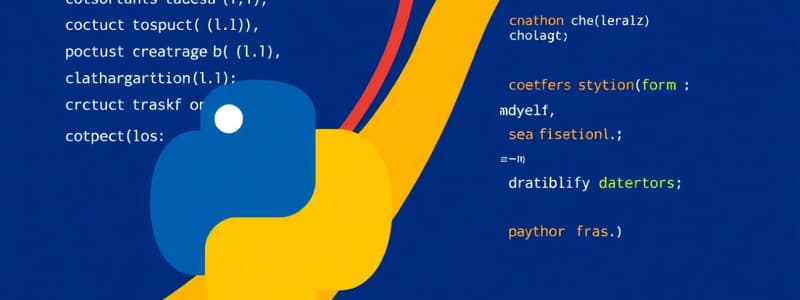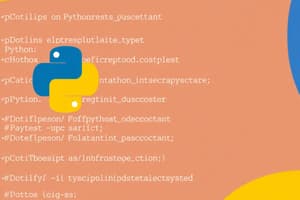Podcast
Questions and Answers
What keyword is used to define a function in Python?
What keyword is used to define a function in Python?
def
What is the purpose of the import statement in Python?
What is the purpose of the import statement in Python?
To load modules
What data structure uses key-value pairs?
What data structure uses key-value pairs?
Dictionary
What type of loop executes as long as a condition is true?
What type of loop executes as long as a condition is true?
What punctuation is used to indicate a comment in Python?
What punctuation is used to indicate a comment in Python?
What function is used to open a file in Python?
What function is used to open a file in Python?
What is the output of print(type(10))?
What is the output of print(type(10))?
What is the value of x after the code x = 5; x += 2?
What is the value of x after the code x = 5; x += 2?
What is the purpose of the break statement in a loop?
What is the purpose of the break statement in a loop?
Name one popular Python library for numerical computing.
Name one popular Python library for numerical computing.
Is Python dynamically typed or statically typed?
Is Python dynamically typed or statically typed?
What are the values of the boolean type in Python?
What are the values of the boolean type in Python?
What method is used to add an element to the end of a list?
What method is used to add an element to the end of a list?
What is the purpose of the try and except block?
What is the purpose of the try and except block?
What is a virtual environment used for?
What is a virtual environment used for?
What is Flask?
What is Flask?
Name a data structure that is immutable.
Name a data structure that is immutable.
What does the 'w' mode do when opening a file using the open() function?
What does the 'w' mode do when opening a file using the open() function?
What is the output of print("Hello".lower())?
What is the output of print("Hello".lower())?
What is pip?
What is pip?
Flashcards
What is Python?
What is Python?
High-level, general-purpose language focused on code readability.
Basic Python Data Types?
Basic Python Data Types?
Integers, floats, strings, and booleans.
What are Lists?
What are Lists?
Ordered, mutable collections, that can contain elements of different types.
What are Tuples?
What are Tuples?
Signup and view all the flashcards
What are Dictionaries?
What are Dictionaries?
Signup and view all the flashcards
What are Sets?
What are Sets?
Signup and view all the flashcards
if, elif, else statements?
if, elif, else statements?
Signup and view all the flashcards
break statement?
break statement?
Signup and view all the flashcards
continue statement?
continue statement?
Signup and view all the flashcards
pass statement?
pass statement?
Signup and view all the flashcards
def keyword?
def keyword?
Signup and view all the flashcards
Lambda function?
Lambda function?
Signup and view all the flashcards
What is a Module?
What is a Module?
Signup and view all the flashcards
What are Packages?
What are Packages?
Signup and view all the flashcards
try and except blocks?
try and except blocks?
Signup and view all the flashcards
with statement in File I/O?
with statement in File I/O?
Signup and view all the flashcards
What are List Comprehensions?
What are List Comprehensions?
Signup and view all the flashcards
What is NumPy?
What is NumPy?
Signup and view all the flashcards
Study Notes
- Python is a high-level, general-purpose programming language.
- It emphasizes code readability with its notable use of significant indentation.
- Python is dynamically typed and garbage-collected.
- It supports multiple programming paradigms, including structured (particularly procedural), object-oriented, and functional programming.
- Python is often described as a "batteries included" language due to its comprehensive standard library.
- Python consistently ranks among the most popular programming languages.
Basic Syntax and Data Types
- Python uses indentation to define code blocks instead of curly braces or keywords.
- Comments are denoted by the hash symbol (#).
- Basic data types include integers, floating-point numbers, strings, and booleans.
- Strings can be defined using single quotes, double quotes, or triple quotes for multi-line strings.
- Python is dynamically typed, meaning the type of a variable is determined at runtime.
Control Flow
if,elif, andelsestatements are used for conditional execution.forloops iterate over a sequence (e.g., a list, tuple, string).whileloops execute as long as a condition is true.breakstatement exits the loop.continuestatement skips the current iteration and proceeds to the next.passstatement is a null operation; it does nothing.
Data Structures
- Lists are ordered, mutable collections that can contain elements of different types, defined using square brackets
[]. - Tuples are ordered, immutable collections defined using parentheses
(). - Dictionaries are unordered collections of key-value pairs, defined using curly braces
{}. - Sets are unordered collections of unique elements, defined using curly braces
{}or theset()constructor.
Functions
- Functions are defined using the
defkeyword. - Arguments are passed to functions inside the parentheses.
- Functions can return values using the
returnstatement. - If there is no explicit
returnstatement, the function returnsNone. - Lambda functions are small, anonymous functions defined using the
lambdakeyword. - Example:
lambda x: x * 2(a lambda function that multiplies its argument by 2).
Modules and Packages
- A module is a file containing Python definitions and statements, which can be imported into other Python programs.
- Packages are a way of organizing related modules into a directory hierarchy.
- The
importstatement is used to import modules or specific attributes from modules. from module import nameimports a specific name from a module.import module as aliasimports a module with an alias.
Object-Oriented Programming (OOP)
- Python is an object-oriented language, supporting classes, objects, inheritance, polymorphism, and encapsulation.
- Classes are defined using the
classkeyword. - Objects are instances of classes.
- Methods are functions defined inside a class.
- The
selfparameter refers to the instance of the class. - Inheritance allows a class to inherit attributes and methods from another class (parent class).
File I/O
- The
open()function is used to open a file. - Modes include
'r'(read),'w'(write),'a'(append), and'b'(binary). - The
read()method reads the entire file. - The
readline()method reads a single line. - The
write()method writes a string to the file. - The
close()method closes the file. - The
withstatement provides a way to automatically close the file after it is used.
Exception Handling
- Exceptions are errors that occur during program execution.
tryandexceptblocks are used to handle exceptions.- The
tryblock contains the code that might raise an exception. - The
exceptblock contains the code that handles the exception. finallyblock contains code that will be executed whether an exception occurs or not.raisestatement is used to raise an exception manually.
List Comprehensions
- List comprehensions provide a concise way to create lists.
- Example:
[x * 2 for x in range(10) if x % 2 == 0]creates a list of even numbers multiplied by 2.
Popular Libraries
- NumPy: Numerical computing library, provides support for large, multi-dimensional arrays and matrices.
- Pandas: Data manipulation and analysis library, provides data structures for efficiently storing and manipulating data.
- Matplotlib: Plotting library, used to create static, interactive, and animated visualizations.
- Scikit-learn: Machine learning library, provides tools for classification, regression, clustering, dimensionality reduction, and model selection.
- Requests: HTTP library, used to send HTTP requests.
- Django/Flask: Web frameworks, used to build web applications.
Virtual Environments
- Virtual environments isolate project dependencies.
venvmodule is used to create virtual environments.- Activate the virtual environment before installing packages.
pipis the package installer for Python.
Small Project Ideas in Python
- Simple Calculator: A command-line or GUI-based calculator that performs basic arithmetic operations.
- To-Do List Application: A program that allows users to add, remove, and track tasks.
- Number Guessing Game: A game where the user tries to guess a randomly generated number.
- Rock-Paper-Scissors Game: A simple game against the computer.
- Basic Web Scraper: A program that extracts data from a website.
- Simple Web Application using Flask: Develop a small web app, like a blog or a URL shortener.
- File Organizer: A script that automatically organizes files into folders based on their extensions.
- Password Generator: A program that generates random passwords of a specified length and complexity.
Studying That Suits You
Use AI to generate personalized quizzes and flashcards to suit your learning preferences.




